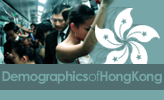Hong Kong comics
 |
| Demographics and Culture of Hong Kong |
|---|
| Demographics |
| Culture |
| Other Hong Kong topics |
|
|
Hong Kong Comics (Chinese: 港漫) are manhua originally produced in Hong Kong.
History
Sun Yat-Sen established the Republic of China in 1911 using Hong Kong's manhua to circulate anti-Qing propaganda. Some of the manhua that mirrored the early struggles of the transitional political and war periods were The True Record and Renjian Pictorial.[1] By the time the Japanese occupied Hong Kong in 1941, all manhua activities had stopped. With the defeat of the Japanese in 1945, political mayhem between Chinese Nationalists and Communists took place. One of the critical manhua, This Is a Cartoon Era by Renjian Huahui made note of the political backdrop at the time.[1]
The turmoil in China continued into the 1950s and 1960s. The rise of Chinese immigration turned Hong Kong into the main manhua-ready market, especially with the baby boom generation of children. The most influential manhua magazine for adults was the 1956 Cartoons World, which fueled the best-selling Uncle Choi. The availability of Japanese and Taiwanese comics challenged the local industry, selling at a pirated bargain price of 10 cents.[1] Manhua like Old Master Q were needed to revitalize the local industry.
The arrival of television in the 1970s was a changing point. Bruce Lee's films dominated the era and his popularity launched a new wave of Kung Fu manhua.[1] The explicit violence helped sell comic books, and the Government of Hong Kong intervened with the Indecent Publication Law in 1975.[1] Little Rascals was one of the pieces which absorbed all the social changes. The 1995 amendment on the Control of Obscene and Indecent Articles Ordinance have much influence on the industry.[2] The materials would also bloom in the 1990s with work like McMug and three-part stories like "Teddy Boy", "Portland Street" and "Red Light District".[1] Many famous painters such as Wong Yuk-Long appeared.[3] A comics publishing company, The Jademan (Holdings) Ltd (now Culturecom Holdings Ltd.) Initial public offering in 1986.[4][5] Chinese translation of Japanese manga are also very popular.
Since the 1950s, Hong Kong's manhua market has been separate from that of mainland China. Hong Kong's transfer of sovereignty back to China in 1997 may signify a reunification of both markets. Depending on how cultural materials are to be handled, especially via self-censorship, the much larger audience in the mainland can be beneficial to both.
Sun Zi's Tactics by Lee Chi Ching won the first International Manga Award in 2007 and Feel 100% by Lau Wan Kit won the second International Manga Award in 2008.
Characteristics
Modern Chinese-style manhua characteristics is credited to the breakthrough art work of the 1982 Chinese Hero.[1] It had innovative, realistic drawings with details resembling real people. Most manhua work from the 1800s to the 1930s contained characters that appeared serious. The cultural openness in Hong Kong brought the translation of American Disney characters like Mickey Mouse and Pinocchio in the 1950s, demonstrating western influence in local work like Little Angeli in 1954.
The influx of translated Japanese manga of the 1960s, as well as televised anime in Hong Kong also made a significant impression. Unlike manga, manhua comes in full colour with some panels rendered entirely in painting for the single issue format. Many of local produced comics are published weekly, and have published for many hundred volumes over many years and have not finished yet.[6]
Notes
- 1 2 3 4 5 6 7 Wong, Wendy Siuyi. [2002] (2001) Hong Kong Comics: A History of Manhua. Princeton Architectural Press, New York. ISBN 1-56898-269-0
- ↑ 《情侶週刊》事件
- ↑ 漫畫自由國度‧漫人偶像
- ↑ 港漫歷史 1970~2003
- ↑ 香港漫画发展简史
- ↑ 長壽港漫介紹
See also
- Manhua
- List of manhua
- List of manhua publishers
- Animation-Comic-Game Hong Kong
- Chinese animation
- Hong Kong Comics: A History of Manhua
References
- Wai-ming Ng (2003). "Japanese Elements in Hong Kong Comics: History, Art, and Industry". International Journal of Comic Art. 5 (2):184–193.
